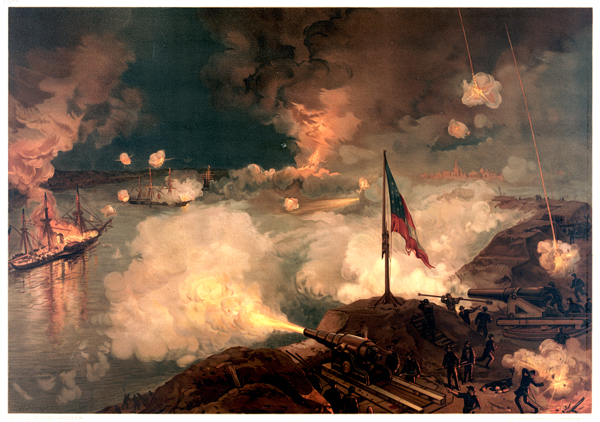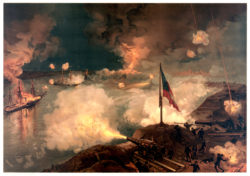Siege of Port Hudson
The capture of Port Hudson in Louisiana gave Union forces control of the Mississippi River and was a significant turning point in the Civil War.
This entry is 7th Grade level View Full Entry

Library of Congress Prints and Photographs Division
"Battle of Port Hudson" published by L. Prang & Co., Boston, c.1887.
Why was the capture of Port Hudson in Louisiana a significant turning point in the Civil War?
The siege and eventual surrender of Port Hudson in June and July of 1863 remains one of the most forgotten turning points of the Civil War. Aside from taking away Confederate control over naval and commercial traffic on the Mississippi River, the fall of Port Hudson changed the course of the war.
Located twenty-five miles upriver from Baton Rouge, Port Hudson only had a small population, but emerged during the antebellum period as a transit depot for the booming cotton and sugar trades. Port Hudson played a major role in Confederate defense on the Mississippi River, but its significance wasn’t realized until Union forces captured New Orleans in April 1862. Despite the Confederacy’s misplaced confidence in Fort St. Philip and Fort Jackson, on the Mississippi River below New Orleans, many people wrongly believed that Port Hudson would be fortified in the future to protect Baton Rouge and New Orleans from attackers coming down the river. The Confederates fortified Vicksburg, Mississippi, and Port Hudson only after Baton Rouge and New Orleans fell to the Union. By controlling these strongholds on the Mississippi, the Confederacy was able to retain control over the strategic intersection of the Mississippi and Red Rivers, which was of great significance to the Southern war effort.
In many ways Port Hudson was more defendable than Vicksburg (the site of another famous siege during the Civil War). The terrain offered its defenders greater protection against attack in virtually every direction, not to mention the fact that it didn’t have a large civilian population. Situated atop eighty-foot-high bluffs, Port Hudson offered an impressive view of the river. It was located in a sharp bend of the river, so vessels had to navigate carefully to avoid running aground. A ship rounding this bend would be exposed to Confederate guns, since the river followed a course directly away from the bluff. Natural obstacles made any landward attack against Port Hudson an equally difficult task. The defensive lines followed a two-mile north-south arc full of deep ravines, dense forests, and swamps. Only a handful of roads and a rail line from Clinton offered access to Port Hudson by land.
When Confederate Major General John C. Breckinridge failed to retake Baton Rouge from Union forces in August 1862, he retreated to Port Hudson and began overseeing the site’s fortification, which in many ways was of greater strategic value and was easier to defend than Baton Rouge. Major General Franklin Gardner, a gifted engineer and a graduate of the United States Military Academy at West Point, succeeded Breckinridge. His leadership enabled Port Hudson to maximize its limited strength in manpower and inspired confidence and good morale among soldiers at the garrison. These valuable assets would prove crucial in the coming months.
The effective command of Port Hudson’s garrison stood in contrast to the divided and at times questionable leadership of Union forces charged with dislodging the Confederate defenders. At one end of the spectrum stood the successful and courageous veteran naval commander Rear Admiral David Glasgow Farragut, who had bravely taken Fort Jackson and Fort St. Philip in order to capture New Orleans. In contrast Major General Nathaniel P. Banks was significantly less suited as a military commander. He was a gifted politician who served as a congressional representative, speaker of the US House of Representatives, and governor of Massachusetts. However, he repeatedly demonstrated his ineffectiveness as a general during the first year of the war in Virginia and continued to do so in Louisiana. In November 1862 Banks replaced Major General Benjamin Butler and arrived in New Orleans with orders to eliminate the Confederate threat at Port Hudson.
On March 14, 1863, Banks was supposed to march more than ten thousand men to the outskirts of Port Hudson in a coordinated attack with Farragut’s Gulf Blockading Squadron that would enable the fleet to pass the powerful Confederate batteries at Port Hudson. Instead of attacking, however, Banks’s inexperienced troops listened to the raging battle between Farragut’s naval forces and the Confederates at Port Hudson in the distance without joining the fight. A small escort and Farragut’s flagship, the Hartford, were the only vessels that managed to pass through Port Hudson. Confederate gunners sank one ship, the Mississippi, and inflicted major damage on the remainder of the squadron, forcing it to retreat downriver.
After the March 14 battle, Banks hesitated to attack Port Hudson because he overestimated the number of Confederate defenders. Instead he sought reinforcements from his superiors while also recruiting and training local Black troops to bridge the gap he perceived to be his numerical disadvantage. It is important to note that the Confederate force included no more than seven thousand men during the campaign, and sometimes far fewer. In contrast Banks consistently had a force that was more than twice the size of his enemy’s. During this delay the Confederates improved Port Hudson’s defenses and gathered more food and ammunition.
Union forces faced a well-entrenched army by the time they moved into position for the attack on May 27. Banks’s soldiers faced several significant handicaps. Many were ninety-day volunteers whose enlistments were set to expire at the end of August, and a large portion of his men had never served in combat. From the very beginning, the Union’s daylong assault, which was led by Black troops from the First and Third Native Guards, was unsuccessful. Rather than a coordinated advance, Union soldiers struggled over the difficult terrain. By nightfall there were scores of dead and dying Union men lying along the approaches to Port Hudson. The disastrous campaign resulted in 1,995 casualties, including almost three hundred deaths. Confederate forces suffered 235 casualties.
The May 27 assault was the first time that Black troops had engaged in a meaningful, front-line combat situation. Like most inexperienced citizen-soldiers during the war, the Native Guards were unable to do much against a battle-hardened enemy, but their performance proved that Black troops could fight and die just as well as white troops. The Native Guards’ deeds were widely publicized and used as a recruiting tool. By the end of the war, 180,000 Black men would serve in the Union Army and twenty thousand in the Union Navy.
After his initial failure to take Port Hudson through frontal assault, Banks decided to lay siege to the site. On June 1 Union engineers started building breastworks and fortifications, digging sap trenches, and setting up artillery for long-term bombardments. Union mortar boats kept up a steady barrage several miles downriver. During the following weeks, Union soldiers, Confederate soldiers, and civilians all suffered. Union troops were poorly provisioned and poorly housed. When Confederate food reserves ran low inside Port Hudson, the soldiers resorted to eating mules, cats, rats, and marginally nutritious grains. This poor diet made disease and fatigue more common among soldiers. Difficult conditions caused low morale in both armies, but especially in the Union trenches where many of the men’s enlistments would soon expire. These recruits started avoiding dangerous jobs.
In the siege’s second week, Banks attacked the Confederate works again. Although the June 14 attack drew nearer to the defenses of Port Hudson, like the one on May 27, it was a costly failure. A total of 1,792 men died for Banks, including 203 killed in action. The Confederates incurred fewer than fifty casualties. Banks refused to ask for a truce after the assault to collect the wounded, which resulted in more deaths and further lowered morale.
The news of the Confederates’ surrender of Vicksburg reached Port Hudson on July 7, leaving them little choice but to also surrender Port Hudson. Furthermore, a lack of food and supplies meant defeat was inevitable. On July 9 Gardner surrendered the garrison. Enlisted Confederates got parole almost as soon as their paperwork was processed. A lot of men left the war permanently. Confederate officers at Port Hudson, however, were taken prisoner and sent to Memphis or New Orleans. Many of these officers would spend the rest of the war in Union prisoner-of-war camps.
The siege at Port Hudson officially lasted forty-eight days, which made it the longest prolonged siege in American military history. The positive reputation of the Black troops who took part in the battle and siege led to wider participation by formerly enslaved men and contributed to significant social transformations in the wake of their service.
